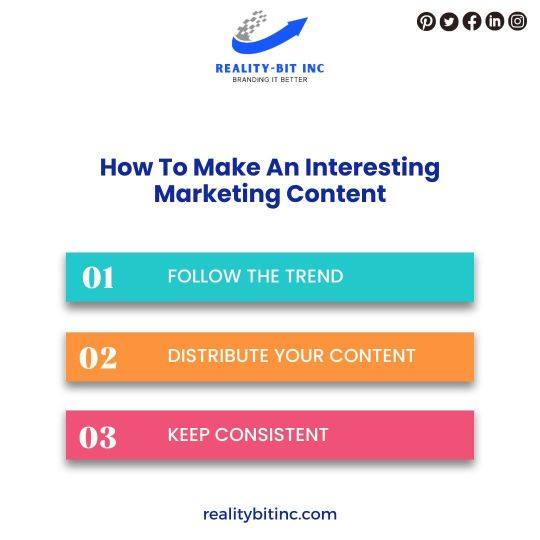#ContentStrategySuccess
Explore tagged Tumblr posts
Text

Craft compelling content: Embrace trends, share consistently, and optimize distribution for an engaging marketing strategy. To know more:- +919970679030 .
#ContentMarketingMagic#TrendyMarketingTips#ConsistentEngagement#CreativeContentCrafting#ContentStrategySuccess#DigitalMarketingInnovation#SocialMediaTrends#EngagingContentCreators#ContentOptimizationJourney#MarketingMastery#TrendingContentIdeas#ConsistentDistribution#ContentCreationExcellence#MarketingMagicMoments#CreativeConsistency#ContentCreatorsUnite#DigitalMarketingSuccess#TrendsettingContent#StrategicContentPlanning#ContentMattersMost
0 notes
Text

Discover the Power of Exceptional Content with Our Professional Content Marketing Services - Let Us Help You Connect with Your Audience and Achieve Your Business Goals.
For more detail Contact us: 88705 78887 https://clickboxagency.com/website-content-writing-service/
#ContentMarketingExperts#EffectiveContentMarketing#ContentMarketingSolutions#ContentStrategySuccess#ContentMarketingDoneRight#ContentMarketingStrategy#QualityContentCreation#ContentMarketingAgency#ContentMarketingSuccess#ContentMarketingTips#EffectiveContentStrategy#ContentMarketingMastery#ContentMarketingForGrowth#ContentMarketingPro
1 note
·
View note
Text
Measuring the Success of Your Content Marketing Strategy: Key Metrics to Monitor
Content marketing is a crucial component of any business’s overall marketing strategy. It involves creating and distributing valuable, relevant, and consistent content to attract and engage a specific target audience. The goal of content marketing is to drive profitable customer action by building a relationship with potential customers and providing them with the information they need to make informed purchasing decisions.

Measuring the success of your content marketing strategy is essential to determining whether your efforts are paying off and making the necessary adjustments to improve your results. Here are some key metrics to measure the success of your content marketing strategy:
Traffic: One of the most basic metrics to measure the success of your content marketing strategy is the amount of traffic your website receives. This includes the number of visitors to your website, the pages they visit, and the time they spend on your site.
Engagement: Engagement metrics measure how engaged your audience is with your content. This includes the number of likes, shares, comments, and views on your content. Engagement metrics are important because they indicate how well your content is resonating with your audience and whether it is inspiring them to take action.
Lead generation: Lead generation metrics measure how well your content is converting visitors into leads. This includes the number of form submissions, email sign-ups, and phone calls generated by your content. Lead generation metrics are important because they indicate how well your content is attracting potential customers and how well it is converting them into leads.
Sales: Sales metrics measure how well your content is converting leads into customers. This includes the number of sales generated by your content and the revenue generated by those sales. Sales metrics are important because they indicate how well your content is performing in terms of driving profitable customer action.
ROI: Return on Investment (ROI) is a metric that measures the return on your investment in content marketing. This includes the cost of creating and distributing your content, as well as the revenue generated by your content. ROI metrics are important because they indicate how well your content is performing in terms of driving profitable customer action.
Measuring the success of your content marketing strategy is essential to determining whether your efforts are paying off and making the necessary adjustments to improve your results. By monitoring and analyzing these key metrics, you can gain valuable insight into the effectiveness of your content marketing strategy and make data-driven decisions to improve your results.
In conclusion, content marketing is a crucial component of any business’s overall marketing strategy. Measuring the success of your content marketing strategy is essential to determining whether your efforts are paying off and making the necessary adjustments to improve your results. By monitoring and analyzing key metrics such as traffic, engagement, lead generation, sales, and ROI, you can gain valuable insight into the effectiveness of your content marketing strategy and make data-driven decisions to improve your results.
#ContentMarketingTactics#ContentCreationTips#ContentStrategySuccess#MarketingPlanning#ContentPromotion#TargetAudienceEngagement#ContentMarketingGoals#BuildingBrandAwareness#ContentOptimization#MeasuringContentSuccess
8 notes
·
View notes
Text
The Power of Storytelling in Your Content Marketing Efforts
Storytelling has long been a powerful tool for human communication and connection. From ancient cave paintings to modern day films and books, stories have the ability to transport us to different worlds and connect us with characters and emotions in ways that simple facts and statistics never could. This same power can be harnessed in content marketing efforts, allowing businesses to connect with their audience on a deeper level and ultimately drive more conversions and sales.

One of the key benefits of using storytelling in content marketing is that it helps to build a strong emotional connection with the audience. People are naturally drawn to stories and can relate to the characters and experiences described in them. By incorporating storytelling into your content marketing efforts, you can create a deeper, more meaningful connection with your audience and make them more likely to engage with your brand and products.
Another benefit of storytelling in content marketing is that it can help to differentiate your brand from your competitors. In today's crowded digital landscape, it can be difficult to stand out and grab the attention of your target audience. By telling unique and engaging stories, you can differentiate your brand and make it more memorable to your audience. This can be especially useful for small businesses and startups looking to establish themselves in a crowded market.
Storytelling can also be used to educate and inform your audience about your products or services. By using stories to demonstrate the benefits of your products or services, you can help to build trust and credibility with your audience. This can be especially useful for businesses in industries such as healthcare or finance, where trust and credibility are crucial to success.
In order to effectively use storytelling in your content marketing efforts, it is important to keep a few key things in mind. First, make sure that your story is relevant and interesting to your target audience. This means understanding their pain points and interests, and tailoring your story to speak directly to them. Secondly, keep your story simple and easy to follow, using clear and concise language to ensure that your message is easily understood. Finally, use storytelling throughout your content marketing efforts, from blog posts and social media updates to email campaigns and video content.
In conclusion, storytelling is a powerful tool that can be used to enhance your content marketing efforts. By building emotional connections with your audience, differentiating your brand, and educating and informing your audience about your products or services, storytelling can help to drive more conversions and sales for your business. So, if you want to take your content marketing efforts to the next level, start incorporating storytelling into your strategy today.
#ContentMarketingTactics#ContentCreationTips#ContentStrategySuccess#MarketingPlanning#ContentPromotion#TargetAudienceEngagement#ContentMarketingGoals#BuildingBrandAwareness#ContentOptimization#MeasuringContentSuccess
13 notes
·
View notes
Text
The Role of SEO in Your Content Marketing Strategy
Search engine optimization (SEO) is a vital aspect of any content marketing strategy. It helps to ensure that your content is easily discoverable by your target audience, and that it ranks well in search engine results pages (SERPs).

When it comes to SEO, there are a number of factors to consider. One of the most important is keyword research. This involves identifying the keywords and phrases that your target audience is likely to use when searching for the types of products or services that you offer. Once you have a list of keywords, you can then optimize your content to include these keywords in the title, meta description, and body of your content.
Another important aspect of SEO is link building. This refers to the process of acquiring links from other websites that point to your own. The more high-quality links you have pointing to your website, the more likely it is to rank well in search engine results. This can be achieved by creating high-quality content that other websites will want to link to, as well as by reaching out to other websites and asking them to link to your content.
In addition to keyword research and link building, there are a number of other SEO tactics that you can use to improve the visibility of your content. These include optimizing images, using header tags, and ensuring that your website is mobile-friendly.
One of the most important things to keep in mind when it comes to SEO is that it is an ongoing process. This means that you will need to regularly update your content, as well as monitor your website's analytics to see how your content is performing. Additionally, you will need to stay up-to-date with the latest SEO trends and best practices, as search engine algorithms are constantly evolving.
Overall, SEO plays a crucial role in any content marketing strategy. By optimizing your content for search engines, you can increase its visibility and reach a wider audience. However, it's important to remember that SEO is just one piece of the puzzle, and that a comprehensive content marketing strategy should also include elements such as social media marketing, email marketing, and influencer marketing.
In conclusion, SEO is a significant aspect in content marketing strategy, it's a process that requires constant monitoring and updating, it's not only about keyword research and link building but also optimizing images, using header tags, and ensuring mobile-friendliness. SEO is just one piece of the puzzle, and a comprehensive content marketing strategy should also include elements such as social media marketing, email marketing, and influencer marketing. To be successful with SEO, it's essential to keep up-to-date with the latest SEO trends and best practices, as search engine algorithms are constantly evolving.
#ContentMarketingTactics#ContentCreationTips#ContentStrategySuccess#MarketingPlanning#ContentPromotion#TargetAudienceEngagement#ContentMarketingGoals#BuildingBrandAwareness#ContentOptimization#MeasuringContentSuccess
8 notes
·
View notes
Text
Content Marketing on a Budget: How to Maximize Your Efforts with Limited Resources

Content marketing can be a powerful tool for businesses looking to connect with their target audience and promote their products or services. However, creating high-quality content can be a time-consuming and expensive process. For businesses with limited resources, it can be challenging to create a content marketing strategy that is both effective and affordable.
One of the key ways to maximize your content marketing efforts on a budget is to focus on creating high-quality, evergreen content. Evergreen content is content that remains relevant and useful over time, as opposed to content that is time-sensitive or tied to a specific event. By creating evergreen content, you can ensure that your content will continue to drive traffic and generate leads for your business long after it is published.
Another way to maximize your content marketing efforts on a budget is to repurpose your existing content. This can include updating older blog posts, creating new content based on existing content, or republishing your content on different platforms. By repurposing your content, you can save time and resources while still reaching a wide audience.
You can also make use of social media platforms to promote your content. Social media platforms like Facebook, Instagram, and Twitter are great places to share your content and reach a wider audience. By creating a social media strategy and consistently posting your content, you can increase your visibility and reach without spending a lot of money.
Another budget-friendly approach is to collaborate with other businesses or influencers in your industry. Partnering with other businesses or influencers can help you reach a wider audience and increase your visibility. By working together, you can share resources and create content that benefits both parties.
In conclusion, creating a content marketing strategy on a budget can be challenging, but it is not impossible. By focusing on evergreen content, repurposing your existing content, making use of social media platforms, and collaborating with other businesses or influencers, you can maximize your content marketing efforts and reach your target audience without breaking the bank. It is important to remember that the most important thing is to create valuable content that resonates with your target audience, regardless of the budget.
#ContentMarketingTactics#ContentCreationTips#ContentStrategySuccess#MarketingPlanning#ContentPromotion#TargetAudienceEngagement#ContentMarketingGoals#BuildingBrandAwareness#ContentOptimization#MeasuringContentSuccess
10 notes
·
View notes
Text
How to Create a Content Marketing Plan that Drives Results
Creating a content marketing plan that drives results is essential for any business looking to build a strong online presence and attract new customers. A well-thought-out plan will not only help you to define your target audience and goals, but it will also ensure that your content is tailored to their needs and interests. Here are a few steps to help you create a content marketing plan that drives results.

Step 1: Define Your Target Audience
The first step in creating a content marketing plan is to define your target audience. This will help you to understand who your ideal customer is and what their needs and interests are. You should consider factors such as age, gender, income, and location, as well as their pain points and goals. Once you have a clear understanding of your target audience, you can tailor your content to meet their specific needs.
Step 2: Set Clear Goals
The next step is to set clear goals for your content marketing plan. These goals should be specific, measurable, achievable, relevant, and time-bound (SMART). For example, you may want to increase website traffic by 20% over the next quarter, or generate a certain number of leads through your blog. Setting clear goals will help you to measure the success of your content marketing plan and make adjustments as needed.
Step 3: Create a Content Calendar
Once you have defined your target audience and set clear goals, it's time to create a content calendar. This is a schedule of when and where you will publish your content, and it should align with your goals and target audience. You should also consider the different types of content you will create, such as blog posts, videos, infographics, and social media updates. A content calendar will help you to stay organized and ensure that you are consistently creating and publishing relevant content.
Step 4: Optimize for Search Engines
To ensure that your content is easily discoverable by your target audience, it's important to optimize it for search engines. This includes including keywords in your content, creating meta tags, and using alt tags for images. This will help your content to rank higher in search engine results, making it more likely to be seen by your target audience.
Step 5: Measure and Analyze Results
The final step in creating a content marketing plan that drives results is to measure and analyze the success of your efforts. This includes tracking metrics such as website traffic, engagement, and conversions. Analyzing these metrics will help you to understand what is working and what isn't, and make adjustments as needed.
Creating a content marketing plan that drives results takes time and effort, but it's worth it in the end. By following these steps, you can ensure that your content is tailored to your target audience and that it helps you to achieve your goals. Remember to always measure and analyze your results, and make adjustments as needed. With a solid content marketing plan, you can build a strong online presence and attract new customers.
#ContentMarketingTactics#ContentCreationTips#ContentStrategySuccess#MarketingPlanning#ContentPromotion#TargetAudienceEngagement#ContentMarketingGoals#BuildingBrandAwareness#ContentOptimization#MeasuringContentSuccess
7 notes
·
View notes
Text
The Future of Content Marketing: Trends and Predictions
Content marketing has been a vital aspect of digital marketing for years, and it shows no signs of slowing down. As technology and consumer behavior continue to evolve, so too must the strategies and tactics used in content marketing. In this article, we will explore some of the key trends and predictions for the future of content marketing.

One trend that is already taking shape is the increased focus on personalized content. With so much information available online, consumers are becoming more discerning about the content they consume. They are looking for content that is tailored to their interests and needs. As a result, businesses must be more strategic in their content creation, ensuring that they are providing valuable and relevant information to their target audience.
Another trend that is expected to gain traction in the future is the use of artificial intelligence (AI) in content marketing. AI-powered tools can be used to analyze data and create personalized content, as well as to measure the effectiveness of marketing campaigns. Additionally, AI-powered chatbots and virtual assistants can be used to engage with customers and provide them with the information they need in real-time.
Video content is also expected to play a bigger role in the future of content marketing. With the rise of platforms like YouTube and TikTok, video is becoming one of the most popular forms of content online. Businesses can use video to showcase their products and services, tell their brand story, and even provide educational content.
Social media is also expected to continue to be a key component of content marketing. As more and more people are spending time on social media, businesses must ensure that their content is optimized for these platforms. They should also look to use social media influencers to reach new audiences and increase brand awareness.
Finally, the future of content marketing is predicted to be more interactive and engaging. With the rise of virtual and augmented reality, businesses will be able to create immersive experiences for their customers that will help them to better understand their products and services. Additionally, interactive content such as quizzes, polls, and surveys will be used to engage with customers and gather valuable data.
In conclusion, the future of content marketing is expected to be more personalized, data-driven, and interactive. Businesses must stay ahead of the curve by using new technologies such as AI and virtual reality, and focus on creating valuable and relevant content that will engage their target audience. By doing so, they can build trust and loyalty with their customers and ensure their long-term success.
#ContentMarketingTactics#ContentCreationTips#ContentStrategySuccess#MarketingPlanning#ContentPromotion#TargetAudienceEngagement#ContentMarketingGoals#BuildingBrandAwareness#ContentOptimization#MeasuringContentSuccess
3 notes
·
View notes
Text
Creating a Content Marketing Strategy: A Beginner's Guide
Creating a content marketing strategy can seem daunting, especially for beginners. However, with a little bit of planning and a clear understanding of your audience and goals, you can develop a content marketing strategy that drives results for your business.
The first step in creating a content marketing strategy is to define your target audience. Who are you trying to reach with your content? What are their needs and pain points? Understanding your audience will help you create content that speaks directly to them and addresses their specific concerns.
Once you have a clear understanding of your target audience, you can begin to define your content marketing goals. What do you hope to achieve with your content? Are you looking to increase brand awareness, generate leads, or drive sales? Having clear goals in mind will help you create content that is aligned with your business objectives.
Next, you will want to develop a content calendar. This will help you plan and schedule your content in advance, ensuring that you are consistently publishing new content and engaging with your audience. When creating your content calendar, consider the different types of content that you will be creating, such as blog posts, social media updates, videos, and infographics.
It's also important to consider the different stages of the buyer's journey when creating your content. The buyer's journey refers to the different stages that a potential customer goes through when considering a purchase, such as awareness, consideration, and decision. Your content should address the specific needs and concerns of your audience at each stage of the buyer's journey.
Once you have a solid content marketing strategy in place, it's important to consistently measure and analyze your results. This will help you understand what is working and what is not, and make adjustments as needed. Some key metrics to track include website traffic, engagement rates, lead generation, and conversions.
In conclusion, creating a content marketing strategy may seem daunting, but it doesn't have to be. By understanding your audience, defining your goals, developing a content calendar, and consistently measuring and analyzing your results, you can create a content marketing strategy that drives results for your business. Remember, a good content marketing strategy is always evolving, so don't be afraid to make adjustments and try new things along the way.
#ContentMarketingTactics#ContentCreationTips#ContentStrategySuccess#MarketingPlanning#ContentPromotion#TargetAudienceEngagement#ContentMarketingGoals#BuildingBrandAwareness#ContentOptimization#MeasuringContentSuccess
3 notes
·
View notes
Text
The Ultimate Guide to Crafting a Content Marketing Strategy
Creating a content marketing strategy is essential for any business looking to increase brand awareness and drive sales. But with so many different elements to consider, it can be overwhelming to know where to start. In this guide, we'll walk you through the key elements of crafting an effective content marketing strategy, and provide tips and best practices for putting it all together.

First and foremost, it's important to understand the goal of your content marketing efforts. Are you looking to increase brand awareness, drive website traffic, or generate leads? Understanding the ultimate goal of your content will help guide the direction of your strategy.
Once you have a clear goal in mind, it's time to start thinking about your target audience. Who are they? What are their pain points and interests? By understanding your audience, you can create content that speaks directly to their needs and resonates with them. This will increase the likelihood that they will engage with your content, and ultimately convert into customers.
Next, you'll need to identify the channels through which you will distribute your content. Will you be using social media, email marketing, or a company blog? Each channel has its own strengths and weaknesses, so it's important to choose the ones that are most effective for reaching your target audience.
Once you have your channels in place, it's time to start creating content. This is where many businesses struggle, but by keeping your target audience and goal in mind, you can create content that is both engaging and effective. It's also important to vary the types of content you create - for example, blog posts, videos, infographics, and social media updates - to keep your audience engaged and interested.
In addition to creating content, it's essential to promote it. Share your content across your chosen channels, and don't be afraid to reach out to influencers or other businesses to help amplify your message. Additionally, consider using paid advertising to boost the visibility of your content.
Finally, it's important to measure the success of your content marketing efforts. Use analytics tools to track engagement, website traffic, and conversions, and use this data to continuously improve your strategy.
In conclusion, crafting a content marketing strategy can seem daunting, but by keeping your goals, target audience, and channels in mind, you can create content that is engaging, effective, and drives results. Remember to promote your content, measure its success and use the data to improve your strategy. A well-crafted content marketing strategy can help increase brand awareness, drive website traffic, and generate leads for your business.
4 notes
·
View notes
Text
Creating a Content Marketing Strategy for a Niche Industry
Content marketing is a powerful tool for businesses looking to establish themselves as thought leaders in their industry. However, for businesses operating in niche industries, creating a content marketing strategy can be a bit more challenging. Niche industries often have a smaller target audience and may not have as much information readily available for content creation. But with the right approach, businesses in niche industries can still create effective and engaging content that resonates with their target audience.

The first step in creating a content marketing strategy for a niche industry is to identify the target audience. In a niche industry, the target audience is likely to be much smaller and more specific than in a larger, more mainstream industry. This means that businesses will need to be more precise and targeted in their content creation efforts. For example, a business in the niche industry of organic gardening may target their content towards experienced gardeners who are looking for information on sustainable gardening practices.
Once the target audience has been identified, businesses need to determine the types of content that will be most effective in reaching and engaging them. In a niche industry, it is important to create content that is both informative and engaging. This may include blog posts, videos, infographics, and white papers that provide valuable information to the target audience. Additionally, businesses should consider creating interactive content such as quizzes, surveys, and polls that allow the target audience to engage with the content in a more interactive way.
Another important aspect of creating a content marketing strategy for a niche industry is to establish a strong online presence. This includes creating a website and social media accounts that are optimized for the target audience. By using keywords that are relevant to the niche industry, businesses can increase their visibility in search engine results and make it easier for the target audience to find their content. Additionally, businesses should make sure that their website and social media accounts are user-friendly and easy to navigate.
Finally, businesses in niche industries should work to establish themselves as thought leaders in their industry. This can be done by creating content that is informative, engaging, and original. Additionally, businesses should make sure that their content is well-researched and contains accurate information. By establishing themselves as thought leaders, businesses can build trust with their target audience and create a strong reputation in the industry.
In conclusion, creating a content marketing strategy for a niche industry can be challenging, but with the right approach, businesses can effectively reach and engage their target audience. By identifying the target audience, determining the types of content that will be most effective, establishing a strong online presence, and working to establish themselves as thought leaders, businesses in niche industries can create a powerful content marketing strategy that resonates with their target audience.
#ContentMarketingTactics#ContentCreationTips#ContentStrategySuccess#MarketingPlanning#ContentPromotion#TargetAudienceEngagement#ContentMarketingGoals#BuildingBrandAwareness#ContentOptimization#MeasuringContentSuccess
2 notes
·
View notes
Text
How to Use Data and Analytics to Improve Your Content Marketing Strategy
Content marketing is a crucial aspect of any business’s digital strategy. It is a way of creating and sharing valuable content to attract and engage with a target audience. However, creating content is only half the battle. To truly succeed in content marketing, it is essential to use data and analytics to measure the effectiveness of your content and improve your strategy.

One of the first steps in using data and analytics to improve your content marketing strategy is to establish key performance indicators (KPIs). These are metrics that you will use to measure the success of your content marketing efforts. Some common KPIs include website traffic, bounce rate, time on site, and conversions. Once you have established your KPIs, you can use tools such as Google Analytics to track and analyze them.
Another important step is to conduct a content audit. A content audit is a process of reviewing all the content on your website or blog to identify which pieces are performing well and which ones are not. You can use data from your analytics to determine which pieces of content are driving the most traffic and engagement. This will help you understand what type of content resonates with your audience and what kind of topics they are interested in.
Once you have a better understanding of your audience and their interests, you can use this information to create more targeted and effective content. For example, if you find that your audience is interested in a particular topic, you can create more content around that topic to engage them further. Additionally, you can use data and analytics to identify the most effective channels for reaching your audience. For example, if you find that your audience is more engaged with your content on social media than on your website, you can focus more on social media marketing.
Another key aspect of using data and analytics to improve your content marketing strategy is to track and analyze the performance of your competitors. By monitoring your competitors’ content, you can identify what type of content is working well for them and what topics they are focusing on. You can then use this information to create your own content that is more competitive and effective.
Finally, it is essential to test and optimize your content. You can use A/B testing to determine which version of your content is more effective. This can include testing different headlines, images, and calls-to-action. By testing and optimizing your content, you can continually improve its performance and make it more effective.
In conclusion, data and analytics are essential tools for improving your content marketing strategy. By establishing key performance indicators, conducting a content audit, understanding your audience, tracking your competitors, and testing and optimizing your content, you can create more effective and engaging content that resonates with your target audience. With the help of data and analytics, you can improve your content marketing efforts and ultimately drive more traffic, engagement, and conversions for your business.
#ContentMarketingTactics#ContentCreationTips#ContentStrategySuccess#MarketingPlanning#ContentPromotion#TargetAudienceEngagement#ContentMarketingGoals#BuildingBrandAwareness#ContentOptimization#MeasuringContentSuccess
3 notes
·
View notes
Text




An effective SEO content strategy involves planning and creating high-quality content that aligns with search engine optimization principles. . . . By conducting keyword research, understanding your target audience, and identifying relevant topics, you can develop a strategic approach to optimize your website's content for improved search engine visibility. . . . #SEOContentStrategy #ContentMarketingSEO #OptimizeYourContent #SEOContentPlanning #ContentStrategyTips #EffectiveSEOContent #ContentStrategySuccess #SEOContentMarketing #ContentOptimization #SEOContentTips #SEOContentStrategy #ContentStrategyForSEO #SEOContentPlanning #OptimizeContentForSEO #ContentStrategySuccess #SEOContentMarketing #ContentCreationForSEO #SEOContentTips
0 notes
Text
Content Marketing Best Practices: How to Measure Success and Adjust Your Strategy
Content marketing is a powerful tool for businesses to connect with their target audience and promote their products or services. However, creating effective content marketing strategies requires more than just producing quality content. To truly be successful, it is essential to measure the effectiveness of your content marketing efforts and adjust your strategy accordingly.

One of the most important content marketing best practices is setting clear, measurable goals. This includes identifying specific metrics that will be used to measure the success of your content marketing efforts. Some common metrics used to measure the success of content marketing include website traffic, engagement (likes, shares, comments), and conversions (sales, leads).
Once you have set clear, measurable goals, it is important to track your progress and analyze the data. This includes monitoring website traffic, engagement, and conversions over time and comparing them to your goals. By analyzing this data, you can identify which strategies are working and which ones need to be tweaked or abandoned altogether.
Another key content marketing best practice is creating a content calendar. A content calendar is a schedule of when and where you will be publishing content. This includes the type of content, the channels it will be published on, and the target audience it is intended for. A content calendar is important for ensuring that your content is consistent, relevant and timely.
In addition, it is important to monitor your competitors and industry trends. This includes keeping an eye on what your competitors are doing, what kind of content is resonating with your target audience, and what new technologies or platforms are emerging. By staying informed about industry trends, you can adjust your strategy and make sure your content is current and relevant.
Lastly, it is important to continually test and optimize your content marketing strategies. This includes experimenting with different types of content, different channels, and different targeting methods. By testing and optimizing your strategies, you can identify what works and what doesn't and make adjustments accordingly.
In conclusion, content marketing is a powerful tool for connecting with your target audience and promoting your products or services. However, to truly be successful, it is essential to measure the effectiveness of your content marketing efforts and adjust your strategy accordingly. This includes setting clear, measurable goals, tracking your progress, analyzing data, creating a content calendar, monitoring your competitors and industry trends, and continually testing and optimizing your strategies. By following these best practices, you can ensure that your content marketing efforts are producing the results you want and help your business grow.
#ContentMarketingTactics#ContentCreationTips#ContentStrategySuccess#MarketingPlanning#ContentPromotion#TargetAudienceEngagement#ContentMarketingGoals#BuildingBrandAwareness#ContentOptimization#MeasuringContentSuccess
2 notes
·
View notes
Text
The Ultimate Guide to Developing a Successful Content Marketing Strategy
Content marketing is a powerful strategy that can help businesses of all sizes to reach their target audience, generate leads, and increase sales. However, developing a successful content marketing strategy is not always easy. In this ultimate guide, we will explore the key elements of a successful content marketing strategy, and provide actionable tips to help you create and implement your own.

Define Your Target Audience The first step in developing a successful content marketing strategy is to define your target audience. This means identifying the demographics, interests, and pain points of the people you want to reach. By understanding your target audience, you can create content that is relevant and valuable to them, which will increase the chances of them engaging with your brand.
Conduct Keyword Research Keyword research is an essential part of any content marketing strategy. This involves identifying the keywords and phrases that your target audience is searching for, and using these keywords in your content to make it more discoverable. By optimizing your content for search engines, you can increase the chances of it appearing in the top search results, which will drive more traffic to your website.
Create a Content Calendar A content calendar is a great way to plan and organize your content marketing efforts. This is a schedule that outlines the types of content you will be creating, when it will be published, and where it will be shared. By creating a content calendar, you can ensure that your content is consistent and relevant, which will help to build trust with your audience.
Create Engaging Content Creating engaging content is the key to a successful content marketing strategy. This means creating content that is informative, valuable, and relevant to your target audience. It should also be visually appealing, easy to read, and shareable. By creating engaging content, you will be more likely to capture the attention of your audience and generate leads.
Promote Your Content Creating great content is only half the battle. You also need to promote your content to ensure that it reaches your target audience. This can be done through social media, email marketing, and other digital marketing channels. By promoting your content, you can increase its visibility and drive more traffic to your website.
Measure and Optimize The final step in developing a successful content marketing strategy is to measure and optimize your efforts. This means tracking your progress and analyzing the data to see what is working and what is not. By measuring and optimizing your content marketing efforts, you can make adjustments and improvements to your strategy to achieve better results.
In conclusion, developing a successful content marketing strategy is not easy, but it is essential for any business looking to reach their target audience and generate leads. By following the steps outlined in this guide, you can create and implement your own content marketing strategy that will help you achieve your business goals. Remember to always keep your target audience in mind, conduct keyword research, create a content calendar, create engaging content, promote your content, and measure and optimize your efforts. With these steps, you will be well on your way to developing a successful content marketing strategy that will help you grow your business.
#ContentMarketingTactics#ContentCreationTips#ContentStrategySuccess#MarketingPlanning#ContentPromotion#TargetAudienceEngagement#ContentMarketingGoals#BuildingBrandAwareness#ContentOptimization#MeasuringContentSuccess
2 notes
·
View notes
Text
Content Marketing on a Budget: How to Make the Most of Your Resources
Content marketing is a crucial aspect of any business's online presence, but it can be difficult to do on a budget. Many small businesses may feel overwhelmed by the cost of creating and promoting high-quality content, but there are many ways to make the most of your resources.

First, it's important to understand that content marketing doesn't have to be expensive. You don't need to hire a professional team or invest in expensive equipment. In fact, many small businesses have found success with simple, low-cost strategies.
One way to save money on content marketing is to create a content calendar. This will help you plan out your content in advance and ensure that you are always creating new and relevant content. This will also help you save time and money by allowing you to create content in bulk, rather than scrambling to come up with something new each time.
Another way to save money is to create a content library. This will allow you to repurpose your existing content in new ways. For example, you can take a blog post and turn it into a video or a social media post. This will save you time and money by allowing you to use the same content in multiple ways.
Social media is also a great way to promote your content on a budget. By creating and sharing high-quality content on social media, you can reach a large audience without spending a lot of money. Additionally, social media allows you to interact with your audience and get feedback on your content.
Finally, it's important to make sure that your content is easily shareable. By including social sharing buttons on your website and blog, you can make it easy for your audience to share your content with their own networks. This will help you reach a larger audience without spending a lot of money on advertising.
In conclusion, content marketing on a budget is definitely possible. By understanding how to make the most of your resources, you can create high-quality content and reach a larger audience without breaking the bank. With a little creativity and some smart planning, you can create a content marketing strategy that will help you grow your business and increase your online presence.
#ContentMarketingTactics#ContentCreationTips#ContentStrategySuccess#MarketingPlanning#ContentPromotion#TargetAudienceEngagement#ContentMarketingGoals#BuildingBrandAwareness#ContentOptimization#MeasuringContentSuccess
1 note
·
View note